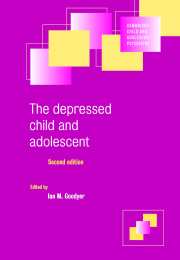Book contents
- Frontmatter
- Contents
- List of contributors
- Preface
- 1 Historical aspects of mood and its disorders in young people
- 2 The development of emotional intelligence
- 3 Developmental precursors of depression: the child and the social environment
- 4 Physiological processes and the development of childhood and adolescent depression
- 5 Childhood depression: clinical phenomenology and classification
- 6 The epidemiology of depression in children and adolescents
- 7 Family–genetic aspects of juvenile affective disorders
- 8 Life events: their nature and effects
- 9 Adolescent depression: neuroendocrine aspects
- 10 Suicidal behaviour in adolescents
- 11 Psychopharmacology of depressive states in childhood and adolescence
- 12 The psychotherapeutic management of major depressive and dysthymic disorders in childhood and adolescence: issues and prospects
- 13 Natural history of mood disorders in children and adolescents
- Index
2 - The development of emotional intelligence
Published online by Cambridge University Press: 18 December 2009
- Frontmatter
- Contents
- List of contributors
- Preface
- 1 Historical aspects of mood and its disorders in young people
- 2 The development of emotional intelligence
- 3 Developmental precursors of depression: the child and the social environment
- 4 Physiological processes and the development of childhood and adolescent depression
- 5 Childhood depression: clinical phenomenology and classification
- 6 The epidemiology of depression in children and adolescents
- 7 Family–genetic aspects of juvenile affective disorders
- 8 Life events: their nature and effects
- 9 Adolescent depression: neuroendocrine aspects
- 10 Suicidal behaviour in adolescents
- 11 Psychopharmacology of depressive states in childhood and adolescence
- 12 The psychotherapeutic management of major depressive and dysthymic disorders in childhood and adolescence: issues and prospects
- 13 Natural history of mood disorders in children and adolescents
- Index
Summary
Introduction
All animals, including humans, are equipped with a number of more or less autonomic emotion programmes: perceived danger immediately elicits a tendency to flee (the basic fear programme), obstructive entities elicit an automatic tendency to attack (the basic anger programme), and so on. Such basic emotional reactions are mainly controlled by subcorticolimbic brain structures (MacLean, 1993; Schore, 1994). From a Darwinistic point of view, these prewired response syndromes are clearly functional, in the sense that they promote survival. This functionalist perspective seems to be in sharp contrast with the everyday life conception of emotions as disorganizing forces that interfere with one's ability to reason, which is presumably caused by the intrusive quality of emotions: our regular thought processes are often overruled by the emotion programme.
In daily life, we need these automatic emotion programmes on many occasions. Since cognition is much too slow to deal with immediate danger (Arnold, 1960), the primitive fear programme will sometimes literally function as a life-saving mechanism. Now what about less urgent circumstances? Even then, emotions are still functional in that they warn us that some interest is at stake (Frijda, 1986). However, under these circumstances, the accompanying primitive action impulse does not always serve our best interests in the complex society in which we live. We cannot attack everything that stands in our way or run away from everything that makes us nervous. Basic routines have to be adjusted to social requirements.
The first question that arises is how do we break up an automatic routine? Human emotions have three interacting components.
Keywords
- Type
- Chapter
- Information
- The Depressed Child and Adolescent , pp. 24 - 45Publisher: Cambridge University PressPrint publication year: 2001
- 6
- Cited by



